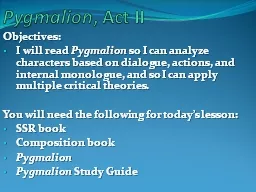

Pygmalion Act II Objectives I will read Pygmalion so I can analyze characters based on dialogue actions and internal monologue and so I can apply multiple critical theories You will need the following for todays lesson ID: 770150
Download Presentation The PPT/PDF document "Pygmalion , Act II Objectives:" is the property of its rightful owner. Permission is granted to download and print the materials on this web site for personal, non-commercial use only, and to display it on your personal computer provided you do not modify the materials and that you retain all copyright notices contained in the materials. By downloading content from our website, you accept the terms of this agreement.
Pygmalion, Act II Objectives: I will read Pygmalion so I can analyze characters based on dialogue, actions, and internal monologue, and so I can apply multiple critical theories. You will need the following for today’s lesson: SSR book Composition book Pygmalion Pygmalion Study Guide
Pygmalion, Act II Volunteer for parts in Pygmalion Act II: Prof. Henry Higgins Col. Pickering Mrs. Pearce Flower Girl / Eliza / Liza Alfred Doolittle As you read, complete the Act II Study Guide.
Pygmalion, Act II What is characterization? The process a writer uses to develop a character. Elements of Characterization Dialogue Actions Interior monologue (what they think) The people with whom they associate What others say about them
Pygmalion, Act II On p. 100 of your SpringBoard book, determine how Bernard Shaw characterizes Eliza, Higgins, Pickering, and Mrs. Pearce. Identify the characteristics of each, and Find textual support for your responses.
Pygmalion, Act II Quick Write Are Higgins and Pickering the gentlemen that they appear to be? Based on what you’ve seen of her so far, how will Eliza need to change in order to be considered a lady?
All you need is a writing instrument. You may NOT use the play, your study packet, or your notes . Put your name and class period on your paper. Mark the letter of your response in the space provided on your quiz. Turn in your quiz at the back table when you finish. Pygmalion Acts I-II Quiz
Objectives: I will read Pygmalion so I can identify and analyze written and unwritten social codes, archetypal patterns, and humorous elements, and apply multiple critical theories. I will read Pygmalion so I can examine characters’ choices and predict characters’ actions. Pygmalion Act III
Volunteer for parts in Pygmalion Act III: Mrs. Higgins Prof. Henry Higgins The Parlormaid Mrs. Eynsford -Hill (Mother) Clara / Miss Eynsford -Hill (Daughter) Freddy Eynsford-HillCol. PickeringEliza / LizaWhiskers / NepommuckFirst Landing FootmanSecond Landing FootmanHostessHostAs you read, complete the Act III Study Guide. Pygmalion Act III
Pygmalion Act III Stop reading on p. 77 after Eliza leaves Mrs. Higgins’ at-home. Answer the questions on p. 101 of your SpringBoard book. Satire – using humor to make a point. Shaw uses satire to magnify Eliza’s social blunders. What can we infer from the use of this literary element ? Shaw uses satire to magnify Eliza’s social blunders and emphasize the emptiness of the upper class.
The Social Blunder Archetype: In a transformation story (such as the Pygmalion archetype), after the main character undergoes a transformation, he/she often undergoes a test and fails (commits a social blunder ). This social blunder is often intended to be humorous. Usually, a secondary character will be present who will try to comfort the main character after the mistake has been made. For example, Mrs. Higgins tries to help Eliza by bringing up the weather (a topic Eliza has been told she can discuss), and by telling Eliza sh e has not said anything she shouldn’t have. Pygmalion Act III
Act III: Pygmalion and My Fair Lady
Watch the Ascot Race scene in Act III of My Fair Lady (1:17:44 – 1:29:35). As you watch consider: How has Eliza done at the races up to this point? As they watch the race, is there anything else that can go wrong? What effect is achieved by having Eliza’s social blunder happen at the Ascot races instead of at Mrs. Higgins’ at-home day? Act III: Pygmalion and My Fair Lady
Continue reading the rest of Act III. Consider Mrs. Higgins’ conversation with Higgins and Pickering (p. 79-84). How could Feminist Criticism apply to this passage? As you read, complete your Act III Study Guide. Questions for discussion after finishing Act III: Has Eliza won Higgins’ bet for him ? If so, how? Pygmalion Act III
Pygmalion Acts III-IV Quick Write: Imagine the conversation that might take place between Eliza, Higgins, and Pickering when they return home from the ball. For each character (Eliza, Higgins, and Pickering), answer the following questions: How does your character typically behave and speak? How does your character feel now that the ball is over ? Why does your character feel that way?